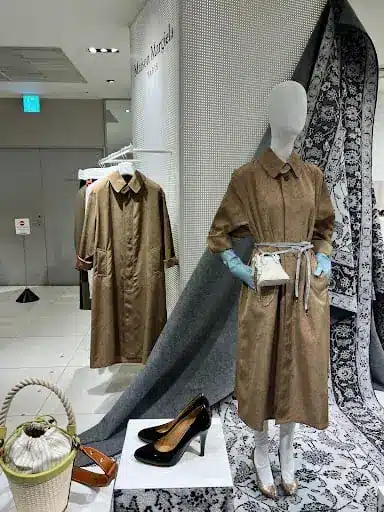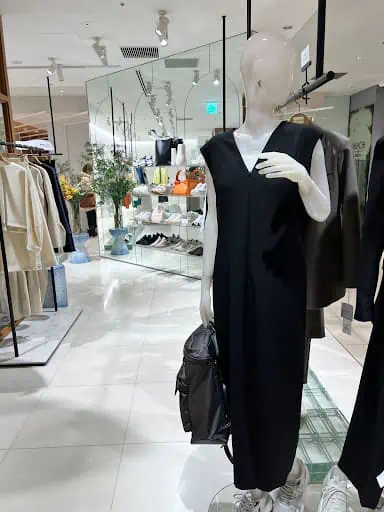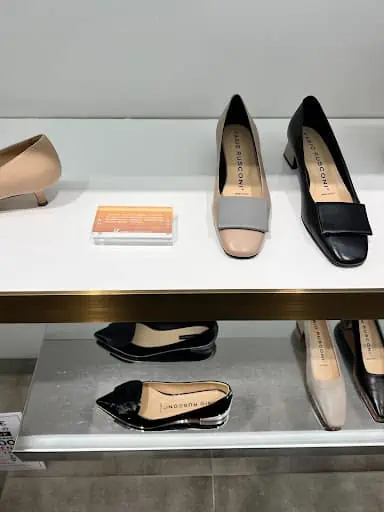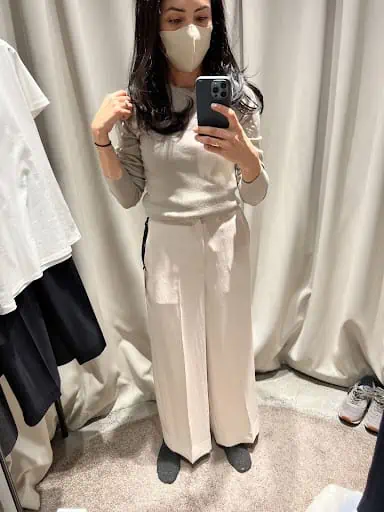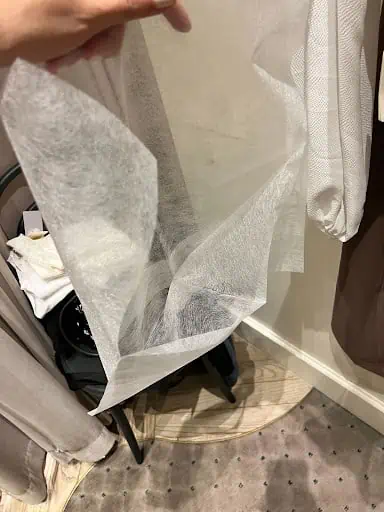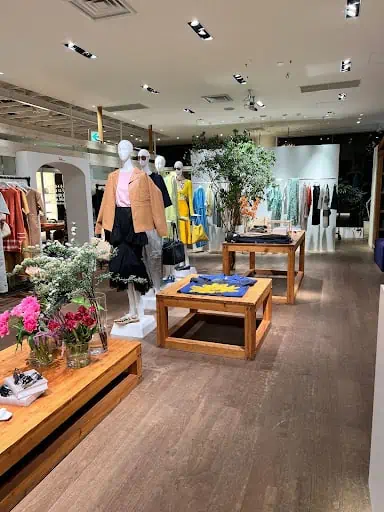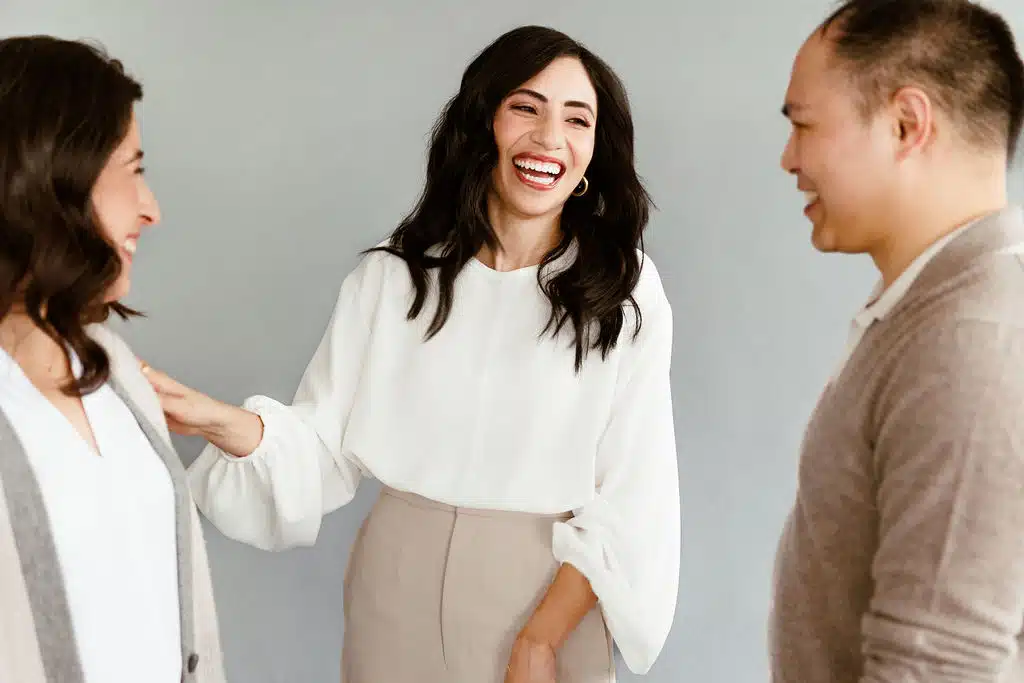A few weeks ago, we told you about our Next Level Wardrobe founder Cassandra Sethi’s recent trip to Tokyo. We shared her complete Tokyo spring style rundown to help you spice up your approach to seasonal style.
This week, we’re pulling back the curtain even more on her trip. While abroad, Cassandra noticed that the clothing choices weren’t the only differences between shopping in Tokyo versus the US.
She picked up on little details like how other shoppers dressed, store displays, and etiquette. Ready to learn what clothes shopping in Japan is really like? Keep reading for our five key observations.
Expect More Conservative Fashion When Shopping in Tokyo
When walking through the busy streets of Tokyo, one thing you’re sure to notice is how conservatively most folks dress.
There, it’s the norm for women to cover their shoulders with long sleeves and heavily layered jackets. You’ll also see longer hemlines, with dresses and skirts almost always extending past the knee.
So why is this?
In general, Japanese culture leans into conformity, unity, and modesty. In the West, we’re used to bolder outfits partially because individuality is such a big part of our culture.
The opposite is true in Japan, especially in older generations and especially in business settings.
Now does this mean all the fashion is drab and covered up? No way.
For one, just as Tokyoites value humble, non-flashy clothing, they also value looking polished and put together. In fact, Japanese business dress codes are notoriously strict.
Secondly, Tokyo is a fashion capital. The people there find chic ways to stay covered and on-trend. For example, you’ll see loads of luxurious, sleek coats and boldly cut types of women’s blazers.
Dark Color Schemes
Another thing we noticed while clothes shopping in Tokyo, Japan was the dark color scheme. Here, black, navy, and other moody tones reign supreme.
This also ties into Japan’s culture of uniformity and not sticking out too much. These colors read as more polished and even “polite”.
Of course, Tokyo’s affinity for dark colors isn’t unique. Go to any big city and you’ll notice that people (especially in financial districts and business-minded circles) prefer black.
Think of Paris, for example. The ultimate “French girl” look involves simple, tailored clothing, and a whole lot of black. You’ll see similar styles in New York too.
We know what some of you are thinking. “Wait, I thought Japanese street fashion was super colorful and extravagant?”
It’s true that many innovative, creative, and avant-garde styles come out of Tokyo. But those are the exceptions rather than the rule. Those bold fashion choices usually come from younger generations and subcultures, just like in the US
(Think of how Gen Zers dress on TikTok versus how you dress as a professional.)
Overall, you’re way more likely to see corporate casual attire-type clothing while shopping in Tokyo than anything else.
Shopping in Japan: Choose Flats Over Heels
Lately, we’ve noticed that our female NLW clients favor flats over heels. As it turns out, Tokyo women are on the same page as well.
Considering that Cassandra walked over 100,000 steps while there, we weren’t surprised. Flats are the best type of office shoes for Tokyo residents, hands down.
Much like other New York, Tokyo is a walking city. Everyone walks everywhere or takes the subway (and they have to walk there too).
Flats and sneakers just make more sense than heels. Plus, they tie into the conservative fashion sense we previously mentioned. Flats and sneakers fit the understated vibe of professional Japanese streetwear.
There were plenty of neutral, put-together options like what you see pictured above. Again, the dark and neutral color palette is key. Additionally, we saw high-end materials to keep these shoes just as office-ready as heels.
Kitten heels were the only heels we spotted while in Japan. There weren’t many shoe options taller than a couple of inches.
Fitting Room Etiquette
We’ve talked about the clothing in Tokyo and trends we noticed in stores. But now, let’s zero in on the shopping experience itself.
As executive stylists, we’re always fascinated by the entire process of finding and buying clothes. We also spend a lot of time in fitting rooms.
One thing that was completely different from the US, was the fitting room etiquette.
In Japan, it’s customary to take off your shoes before entering someone’s home or before entering a culturally traditional space. You can keep your shoes on while browsing stores in Tokyo. However, you do have to take them off in the fitting room.
Why? Because shoes can stain or dirty clothes. Store owners don’t want customers damaging their merchandise and shoppers want to be courteous.
What’s another way that store owners ensure folks keep their clothes in tip-top shape? They ask shoppers to wear face coverings while in the fitting room.
Again, the face covering protects garments from makeup when pulling clothes on over your head.
(We’ve all seen that tell-tale makeup ring on shirt collars before.)
You can usually find face coverings in the fitting room, or you can ask an assistant for one.
Customer Service is Everything in Japanese Retail
A day in the life of an image consultant involves visiting countless stores and working with hundreds of store associates.
Rest assured, we’ve seen the good, the bad, and the ugly in that department. And while we’ve had amazing experiences in American stores, you can’t expect the same level of service everywhere.
But in Tokyo, the customer service was impeccable at every store Cassandra visited.
Clerks and store owners go out of their way to ensure you’re enjoying your time in their store. They thoughtfully wrap your purchase in tissue and a nice bag. They take and hand back you credit card with two hands and they’ll even walk you to the exit saying thank you along the way.
We hope you enjoyed learning about our clothes-shopping adventures in Japan. If you’re interested in more posts like these, let us know. Leave a comment on our Instagram or send us an email at [email protected].
Interested in working with us? Apply for NLW’s executive image and personal styling services. We have a fully-equipped team that’s ready to change the way you shop for good.

